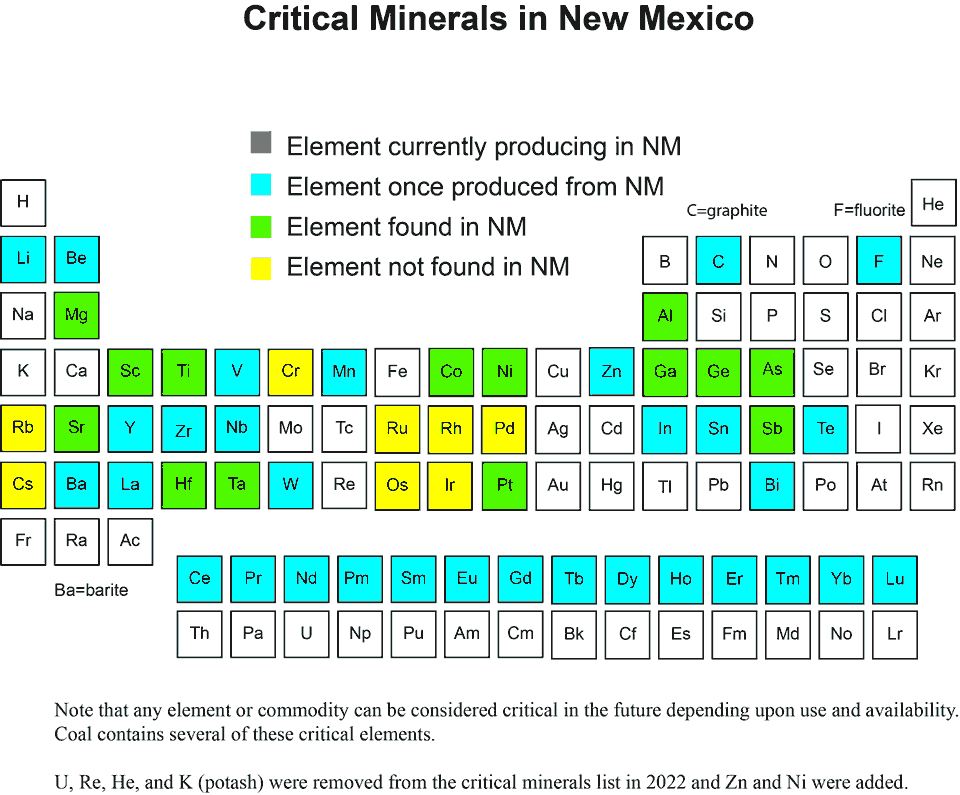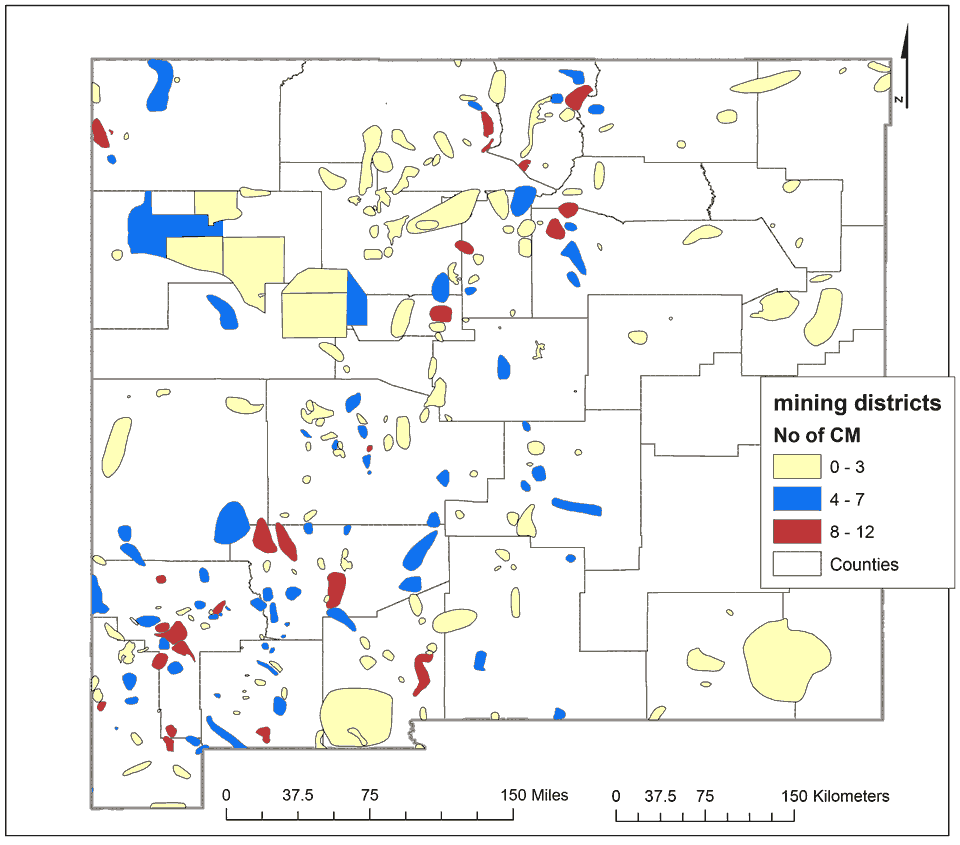
Critical Minerals in New Mexico
On This Page
What are Critical Minerals?
There are many definitions of critical minerals that depend upon country, supply and demand, and strategic conditions (Jowitt et al., 2018), the best definition was proposed by U.S. President Eexecutive Order (2017) that required the Departments of Interior and Defense to develop a list of critical minerals. In May 2018, the U.S. Department of the Interior published its final list of 35 critical minerals (Table 1, Fig. 1). As defined by EO No. 13817, “a critical mineral is a mineral (1) identified to be a nonfuel mineral or mineral material essential to the economic and national security of the United States, (2) from a supply chain that is vulnerable to disruption, and (3) that serves an essential function in the manufacturing of a product, the absence of which would have substantial consequences for the U.S. economy or national security”. Many critical minerals are minerals, metals, non-metals and other raw materials that are 100% produced in other countries and imported into the U.S. Critical minerals are mineral resources that are essential to our economy and whose supply may be disrupted. In many cases, geological resources are available in the world, but the real issue is potential supply disruptions, therefore, life-cycles of the various critical minerals are important. Disruptions in supply chains can arise for any number of reasons, including natural disasters, labor strife, trade disputes, resource nationalism, conflict, and so on. As demand and supplies of raw materials evolve, criticality of a commodity can change with time and geography as society's needs evolve. In 2022, the USGS revised the list of critical minerals (removed U, Re, potash, He and added Ni and Zn)..
COMMODITY |
IS IT FOUND IN NEW MEXICO? |
WAS IT PRODUCED FROM NEW MEXICO? |
|---|---|---|
Aluminum (bauxite) |
? |
No |
Antimony (Sb) |
Yes |
Yes |
Arsenic |
Yes |
Yes |
Barium (barite) (Ba) |
Yes |
Yes |
Beryllium (Be) |
Yes |
Yes |
Bismuth (Bi) |
Yes |
Yes |
Cesium (Cs) |
? |
No |
Chromium |
? |
No |
Cobalt (Co) |
? |
No |
Fluorine (fluorite) (F) |
Yes |
Yes |
Gallium (Ga) |
Yes |
No |
Germanium (Ge) |
? |
No |
Graphite (carbon) |
? |
Yes |
Hafnium (Hf) |
? |
No |
Indium (In) |
Yes |
No |
Lithium (Li) |
Yes |
Yes |
Magnesium (Mg) |
Yes |
No |
Manganese (Mn) |
Yes |
Yes |
| Nickel (Ni) | Yes | Yes |
Niobium (Nb) |
Yes |
Yes |
Platinum group elements (PGE: Pd, Pt, Os, Ir, Rh) |
? |
No |
Rare earth elements (REE), including yttrium (Y) |
Yes |
Yes |
Rubidium (Rb) |
? |
No |
Scandium (Sc) |
Yes |
No |
Strontium (Sr) |
? |
No |
Tantalum (Ta) |
? |
No |
Tellurium (Te) |
Yes |
Yes |
Tin (Sn) |
Yes |
Yes |
Titanium (Ti) |
Yes |
No |
Tungsten (W) |
Yes |
Yes |
Vanadium (V) |
Yes |
Yes |
Zirconium (Zr) |
Yes |
No |
| Zinc (Zn) | Yes | Yes |

The concept of critical minerals is not new and emerged in the U.S. after World War 1. In 1922, the Army and Munitions Board was established in the War Department to plan for mobilization and procurement of materials, including raw commodities, required by the military. The Strategic and Critical Minerals Stockpiling Act was passed in 1939 to provide stockpiles of commodities required for national defense at that time. Another Strategic and Critical Minerals Stockpiling Act was passed in 1946. The U.S. stockpiles increased through the early 1960s, when materials no longer needed were sold. Additional acts were passed by Congress over the years concerning mineral resources. The U.S. Geological Survey and the former U.S. Bureau of Mines conducted mineral resource assessments since 1960 to evaluate mineral-resource potential within the U.S., especially in wilderness areas that included critical minerals. In 1973, the National Uranium Resource Evaluation (NURE) program was initiated by the Atomic Energy Commission (AEC) and later administered by the Department of Energy to identify uranium resources in the United States (https://pubs.usgs.gov/of/1997/ofr-97-0492/nurehist.htm) and was one of the few programs that examined most of the United States for mineral-resource potential.
Understanding the geology of critical minerals (and other minerals) as well as how to explore, mine and process these resources, utilize them in our products, recycle them, and maintain healthy ecosystems is just as important today as in the past.
Why are Critical Minerals Important?
The list of critical elements varies from country to country (Table 1). Although there have been many reports describing how to determine if a mineral is critical, four criteria seem to be universally important. One of the most important criteria to determine if a mineral is critical is if that mineral is essential in manufacturing important technologies and applications required by society, especially for national defense. Other common traits of critical minerals include:
- Critical minerals generally do not have a viable substitution in the manufacture of important products and many critical minerals cannot be recycled [2].
- Most critical minerals are imported into the country [4] and supply disruptions at some time are likely, in many cases because the country supplying the mineral are politically unstable or has a history of imposing export quotas or other constraints in supply.
- Many critical minerals are found in economic deposits in only a few countries, and that monopoly could result in restricted access. The world-wide supply becomes small compared to traditional base and precious metals, which can result in uncertainties of supply and large fluctuations in price.
Where are critical minerals found in New Mexico?
New Mexico has a wealth of mineral resources and numerous of the critical minerals are found in the state (McLemore, 2019, 2020). The New Mexico Bureau of Geology and Mineral Resources is actively mapping, sampling and evaluating the resource potential for the various critical minerals (Fig. 1) in the state. The only critical mineral currently being produced in New Mexico is potash, which is used for fertilizer and in the chemical industry. The Carlsbad potash district is the largest potash producing area in the U.S., and New Mexico is ranked number one in potash production yearly. Total production from the district is estimated as 115 million tons of salts from 1959-2016. Other critical minerals have been produced from New Mexico in the past (Table 1, Fig. 1). With funding from the USGS, the Bureau is actively evaluating and describing critical minerals in the state.

More details on specific critical minerals can be found at:
- Presentation at AEMA on Critical minerals in New Mexico (2020)
- Alunite
- Barite and fluorite
- Beryllium
- Gallium
- Lithium (mines and occurrences)
- Potash (mines and occurrences)
- Rare earth elements
- Tellurium
- Tin
- Uranium
- Map showing alunite, gallium, lithium, tin, and tungsten deposits in NM.
Some of this material is based upon work partially supported by the U.S. Geological Survey under Earth MRI contracts G19AP00098 and G20AS00008. The views and conslusions contained in this document are those of the authors and should not be interpreted as representing the opinions or polices of the U.S. Geological Survey. Mention of trade names or commercial products does not constitute their endorsement by the U.S. Geological Survey.
References
- U.S. Executive Order No. 13,817, 2017, Presidential executive order on a federal strategy to ensure secure and reliable supplies of critical minerals: https://www.whitehouse.gov/presidential-actions/presidential-executiveorder-federal-strategy-ensure-secure-reliable-supplies-critical-minerals/.
- Jowitt, S.M., Mudd, G.M., Werner, T.T., Weng, Z., Barkoff, D.W., and McCaffrey, D., 2018, The critical metals: An overview and opportunities and concerns for the future, in Arribas, A.M. and Mauk, J.L., eds., Metals, minerals, and society: Economic Geology, Special Publication no. 21, p. 25-38.
- McLemore, V.T., 2019, Critical minerals in New Mexico: SME Annual Meeting, Preprint 19-132, 6 p., https://geoinfo.nmt.edu/staff/mclemore/projects/documents/19_132.pdf
- McLemore, V.T., 2020, Critical minerals in New Mexico; work needed to realize resources: Mining Engineering, v. 72, no. 2, pp. 31-31, https://me.smenet.org/abstract.cfm?preview=1&articleID=9501&page=31


